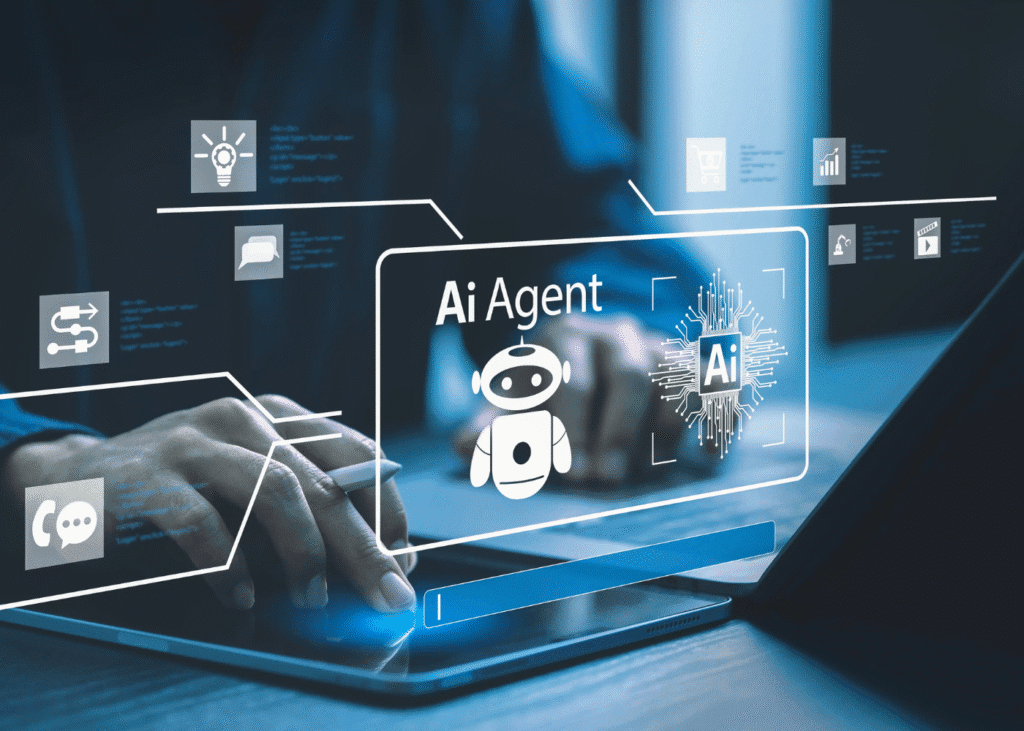
You’re the owner of a successful restaurant. You likely have a manager and a staff. Your manager handles day-to-day operations, ensuring the restaurant runs smoothly. They’ll take care of tasks like managing reservations, ordering supplies, and handling customer complaints, all based on your direction. Your staff, on the other hand, works hard to ensure everything is in place without needing to be told. They’re actively ensuring that the food quality, service, and ambiance are always top-notch, using their expertise to improve the restaurant’s performance without needing constant instruction.
The manager is like the AI agent. They ensure everything runs smoothly and make decisions to improve the business without needing constant instructions from you. They are always working in the background, anticipating needs and opportunities, like how an AI agent works autonomously toward a goal. The staff is like the AI assistant. They fulfil day-to-day duties like cooking, serving customers, and maintaining the restaurant, responding to immediate needs and requests but not proactively seeking ways to improve the business or make broader decisions.
The key difference between an AI assistant and an AI agent works similarly. An AI assistant is reactive, completing tasks based on your instructions. An AI agent, however, is proactive, working independently to achieve a specific goal, finding opportunities, and handling challenges along the way, without waiting for you to direct each step.
In this blog we dive deep into both AI assistants and AI agents, and how do they compare with one another in terms of features and applications. We also discuss the risks that must be considered while opting for either of them as solutions.
What are AI Assistants?
AI assistants, also known as AI chatbots, are AI solutions designed to handle and resolve user queries by interacting with them through text or voice. They mimic the style of humans by using advanced AI technologies such as natural language processing (NLP), sentiment analysis, machine learning (ML), and large language models (LLMs) to understand, process, and respond to user commands and inquiries. Apple’s Siri, Amazon’s Alexa, and OpenAI’s ChatGPT are some of the most common examples of AI assistants that are known globally by all.

How Do AI Assistants Work?
When AI assistants started coming out, they worked on rule-based instructions and preprogrammed responses. Nowadays, they are entirely, if not mostly, made from natural language processing (NLP) and large language models (LLM’s). AI assistants are contingent on user input for effective functioning. They do not possess the ability to take decisions and execute collateral on their own. For example, if you ask, “Remind me to take my medicine at 8PM,” an AI Assistant will set the reminder but won’t take further action unless prompted again. As such, AI assistants won’t take initiatives, and they do not adapt or improve based on user patterns.
Common Use Cases for AI Assistants
Some common use cases for AI assistants include customer chatbots to handle inquiries and FAQ’s, task managers to set reminders and schedule meetings, and generating code for developers to assist them. AI assistants need a defined problem or a query to begin processing. To ensure their optimal performance, they require continuous input from the user. An AI assistant can only give information and output based on the data it has access to it. Thus, it is important to keep updating the data and to regularly check for errors.
What are AI Agents?
An AI agent is an autonomous, AI-powered entities that can resolve a wide array of requests. It goes beyond the power of generative AI, where instead of just assisting you, it can work even on your behalf when you are away from your operations. It can perform a range of functions, from promptly responding to questions to carrying out complex or multistep assignments.

How Do AI Agents Work?
AI agents are autonomous, proactive systems that can make decisions and perform complex tasks without constant human intervention. Unlike AI Assistants, which rely on user input to function, AI agents can break down tasks into smaller steps, gather insights from external data sources, and continuously learn and refine their strategies over time. This autonomy allows them to complete multi-step workflows and solve problems independently, adapting as they gather more data and learn from previous interactions.
Some key features of AI agents include their ability to operate without supervision, make decisions based on available data, and improve through continuous learning. They can also collaborate with other agents or humans, making them effective in scenarios requiring teamwork or coordination. These capabilities enable AI agents to handle tasks that go beyond simple responses, such as monitoring markets, managing smart homes, or conducting cybersecurity operations.
Common Use Cases for AI Agents
Common use cases for AI agents include automating and executing marketing and sales, supply chain optimization, cybersecurity monitoring, smart home management, create dynamic pricing, and autonomous navigation. It’s with applications like these that they are becoming the next big thing in redefining customer experiences in retail.
These applications demonstrate how AI agents can automate complex processes, making them valuable tools in industries ranging from media and finance to transportation and security. By combining autonomy, decision-making, and learning, AI Agents are transforming the way technology can support and collaborate with humans.
AI Agents vs AI Assistants: The Key Differences
AI assistants follow a strict set of explicit instructions from users. These explicit, pre-defined instructions can vary from providing answers, setting reminders, retrieving information, and automating routine tasks. It is capable of handling simpler tasks, thus cutting out the mundanity in human work. Compared to the reactive approach by AI assistants, AI agents are more proactive. Beyond following instructions, it can make decisions and act without direct supervision. It can also derive insights from large datasets, automate and execute entire workflows and thrive in dynamic, ever-changing environments. It can manage any task, especially those that are complex and involve multiple steps.
The differences between AI agents and AI assistants are apparent, but the line between them may be blurred in coming times. As AI assistants become more self-sufficient and AI agents become more user friendly, there may not be much to say about these differences.
The Benefits of AI Assistants and Agents
AI assistants and AI agents offer numerous advantages, enhancing everything from workflow automation to overall user experience:
1. Complementary AI solutions
AI agents are programmed to handle specialized, complicated operations independently, while AI assistants can best comprehend and interact with users naturally and conversationally. Between them, they create a strong and seamless AI system that is easier and more efficient to use, with automation complemented by personalized interaction.
2. Streamlined processes and productivity
AI solutions, such as generative AI, enable businesses to streamline operations, automate repetitive work, and aid in problem-solving, which all lead to greatly improved efficiency and productivity. These solutions enable companies to decrease manual labor and concentrate more on strategic goals.
3. Improved user experience
AI assistants provide more interactive and engaging experiences by learning user preferences and improving over time based on previous interactions. This enables increasingly personalized assistance that addresses individual requirements, leading to greater user satisfaction and better outcomes.
4. Autonomous functioning and scalability
AI agents are able to function independently, handling a variety of tasks at once and scaling their functioning to accommodate complex processes without the need for continuous human intervention. This autonomy makes it possible for businesses to run more effectively, even in huge or dynamic setups.
5. Enhanced task management and collaboration
AI agents can analyze user requirements and delegate tasks to AI assistants, which can subsequently utilize the data generated to generate more intuitive and efficient outputs. This feature boosts collaboration and helps ensure that tasks are performed better by tapping into the strengths of both agents and assistants.
5. Enhanced integration capability
With the ongoing improvement of AI models, they will more and more incorporate conversational and autonomous capabilities, facilitating more seamless handoff between agents and assistants. The development will bring about better-quality outputs in a shorter time frame, further increasing operational efficiency and user satisfaction. More advanced integration will also create opportunities for even more advanced and flexible AI solutions to benefit many industries.
The Risks and Limitations of Using AI Agents & Assistants

AI technologies have certain risks and limits. Large language models (LLMs) are brittle, or they can become invalid with slightest changes to prompts, resulting in erroneous responses, wrong data, or hallucinations. This causes AI agents and assistants to become susceptible to malfunction if the root model suffers mistakes, including hallucinations or breakdowns at structural levels.
AI agents, meanwhile, are still at an early stage of development. They tend to find it difficult to look back at their outcomes, resulting in endless feedback loops. Moreover, as AI agents communicate with external tools and environments, any modification in these tools causes them to malfunction. AI assistants, on the contrary, are more consistent, as they do not usually have dependency on external tools.
AI agents, particularly for complicated tasks, take a lot of training and may spend a long-time performing task. They may also be expensive. Foundation models of today are not sophisticated enough to be used as complete autonomous agents, but with increased model reasoning, the potential of AI agents will improve. As much as the future holds promise for more autonomous applications, human guidance is still frequently required at this point to direct and supervise AI systems.
To overcome most of these problems, having strong data governance and cybersecurity is crucial to ensure that AI does not hallucinate and cost you your brand reputation, money, and resources.
The Bottom Line
AI is the next big thing for businesses looking to save time and money in their operations. Both AI assistants and AI agents works similarly. An AI assistant is reactive, completing tasks based on your instructions. On the other hand, an AI agent is proactive, where it works independently to achieve a specific goal, find opportunities, and handle challenges along the way without waiting for you to direct each step.
While the business value is there for both these AI solutions, there are certain risks and limitations that must be addressed while incorporating them to ensure you steer clear of AI hallucinations and data privacy and security issues. Both the risks and the benefits must be considered while choosing AI agents or assistants. But most importantly, whatever you choose must have a business use case that can be directly solved with them to ensure your costs don’t increase exponentially while using AI in your business.